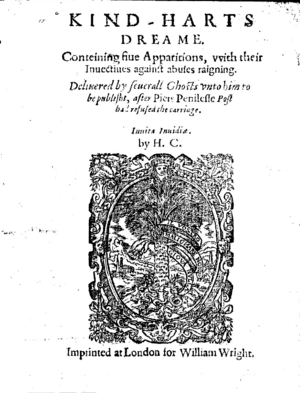Henry Chettle facts for kids
Henry Chettle (born around 1564, died before 1607) was an English writer during the time of Queen Elizabeth I. He was known for writing plays and many short books called pamphlets.
Henry Chettle was a busy writer who worked with many other famous playwrights of his time, like Thomas Dekker and Ben Jonson. He helped create many plays for the popular theaters in London.
Contents
Early Life and Printing
Henry Chettle was the son of Robert Chettle, a dyer in London. In 1577, when he was about 13, Henry started learning a trade. By 1584, he became a member of the Stationers' Company. This was a very important group for people who printed and sold books. They controlled the printing business in England.
Henry worked as a printer and later as an author. He might have helped print some of the pamphlets written during a big argument known as the Martin Marprelate controversy. In 1591, he teamed up with two other printers, William Hoskins and John Danter. Together, they published many songs and some plays. It's even thought that Chettle might have added lines to an early, unofficial version of William Shakespeare's famous play, Romeo and Juliet.
The Groat's-Worth of Wit Mystery
In 1592, a book called Greene's Groats-Worth of Wit was published. It was said to be written by the popular writer Robert Greene, who had recently died. Henry Chettle was involved in publishing it.
This book had a part that criticized other playwrights. Two writers were especially upset: Christopher Marlowe and possibly William Shakespeare. People thought Chettle had actually written the book himself, pretending it was Greene's work.
Chettle denied this. In his own book, Kind Heart's Dream, published later that year, he wrote about it. He said that Greene had left many papers when he died, including Groat's-Worth of Wit. Chettle explained that he didn't know the writers who were offended. He also said he was sorry if he hadn't been careful enough with the original text, especially since the author (Greene) was dead. He even praised one of the offended writers (thought to be Shakespeare), saying he was a good person and excellent at writing plays.
For a long time, experts have argued about whether Greene or Chettle truly wrote Greene's Groat's-Worth of Wit. Some studies using computers to analyze writing styles have suggested it was Chettle, but others still believe it was Greene.
Working with Philip Henslowe
Henry Chettle often seemed to be in debt. Records from Philip Henslowe's diary show that Chettle frequently borrowed small amounts of money. Henslowe was a very important theater manager and businessman in London. He often gave money to playwrights in advance for their plays.
For example, Henslowe once lent Chettle money to get him out of Marshalsea prison in 1599. Another time, in 1603, he lent money to get one of Chettle's plays back from being held as a guarantee for a debt. Chettle borrowed more small amounts from Henslowe than almost anyone else. This suggests they had a friendly relationship. Even though Chettle signed an agreement to write only for Henslowe's theater company, he sometimes wrote for other companies too.
His Plays and Other Writings
By 1598, a writer named Francis Meres mentioned Chettle as one of the "best for comedy." Philip Henslowe's records show payments to Chettle for 36 plays between 1598 and 1603. Chettle might have been involved in writing as many as 50 plays in total! He often worked with other playwrights like Henry Porter, Thomas Dekker, and John Day.
Most of Chettle's plays were not printed, so they are lost today. Only one play that he wrote by himself was printed: The Tragedy of Hoffmann: or a Revenge for a Father. This play was performed in 1602 and printed in 1631. Some people think it might have been written to compete with Shakespeare's famous play, Hamlet.
Besides plays, Chettle also wrote other books. These include Piers Plainnes Seaven Yeres Prentiship (1595), which tells a fictional story of an apprenticeship. He also wrote England's Mourning Garment (1603), which included poems about the main writers of his time.
Death
Henry Chettle died sometime before 1607. In that year, his friend and fellow playwright Thomas Dekker wrote about him. Dekker described Chettle joining other poets in a peaceful afterlife, saying he came in "sweating and blowing by reason of his fatness." This gives us a small glimpse into what Chettle might have been like.
Images for kids



